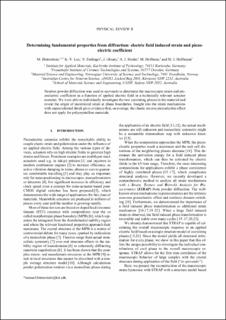| dc.contributor.author | Hinterstein, Manuel | |
| dc.contributor.author | Lee, Kaiyang | |
| dc.contributor.author | Esslinger, Sophia | |
| dc.contributor.author | Glaum, Julia | |
| dc.contributor.author | Studer, Andrew | |
| dc.contributor.author | Hoffman, Mark John | |
| dc.contributor.author | Hoffmann, Michael | |
| dc.date.accessioned | 2020-04-17T13:40:38Z | |
| dc.date.available | 2020-04-17T13:40:38Z | |
| dc.date.created | 2019-07-16T18:14:44Z | |
| dc.date.issued | 2019 | |
| dc.identifier.citation | Physical review B (PRB). 2019, 99 (17), . | en_US |
| dc.identifier.issn | 2469-9950 | |
| dc.identifier.uri | https://hdl.handle.net/11250/2651556 | |
| dc.description.abstract | Neutron powder diffraction was used in operando to determine the macroscopic strain and piezoelectric coefficient as a function of applied electric field in a technically relevant actuator material. We were able to individually investigate the two coexisting phases in the material and reveal the origin of maximized strain at phase boundaries. Insight into the strain mechanisms gives evidence that, on average, the classic inverse piezoelectric effect does not apply for polycrystalline materials. | en_US |
| dc.language.iso | eng | en_US |
| dc.publisher | American Physical Society | en_US |
| dc.title | Determining fundamental properties from diffraction: Electric field induced strain and piezoelectric coefficient | en_US |
| dc.type | Peer reviewed | en_US |
| dc.type | Journal article | en_US |
| dc.description.version | acceptedVersion | en_US |
| dc.source.pagenumber | 6 | en_US |
| dc.source.volume | 99 | en_US |
| dc.source.journal | Physical review B (PRB) | en_US |
| dc.source.issue | 17 | en_US |
| dc.identifier.doi | 10.1103/PhysRevB.99.174107 | |
| dc.identifier.cristin | 1711718 | |
| dc.description.localcode | © American Physical Society 2019. | en_US |
| cristin.unitcode | 194,66,35,0 | |
| cristin.unitname | Institutt for materialteknologi | |
| cristin.ispublished | true | |
| cristin.fulltext | original | |
| cristin.qualitycode | 2 | |
